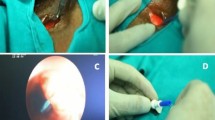Abstract
Propose
The aim of the present article is to propose an alternative technique to the traditional secondary tracheoesophageal puncture (TEP) for voice rehabilitation after total laryngectomy, describing the procedure step-by-step, analyzing the complications and long-term results.
Methods
A retrospective study was conducted on patients who underwent secondary TEP with the blind technique using a rigid hysterometer. The main steps in this technique are described and illustrated. Patient demographics and surgical outcomes were assessed.
Results
Thirty-two patients were enrolled in this study. In all but one case, risk factors that could hinder rigid esophagoscopy were identified (37.5% neopharyngeal/esophageal post-surgical issues, 81.3% prior radiotherapy, 21.9% cervical arthrosis, and 12.5% prior coloplasty or gastric transposition). No intra- or postoperative surgical complications were noted.
Conclusion
The blind technique offers an alternative method to perform a secondary TEP safely and efficiently in patients with unfavorable anatomical or clinical conditions, lowering the risk of procedure-related complications.



Similar content being viewed by others
References
Allegra E, La Mantia I, Bianco MR et al (2019) Verbal performance of total laryngectomized patients rehabilitated with oesophageal speech and tracheoesophageal speech: impacts on patient quality of life. Psychol Res Behav Manage 12:675–681. https://doi.org/10.2147/prbm.s212793
Bozec A, Poissonnet G, Chamorey E et al (2009) Results of vocal rehabilitation using tracheoesophageal voice prosthesis after total laryngectomy and their predictive factors. Eur Arch Otorhinolaryngol 267(5):751–758. https://doi.org/10.1007/s00405-009-1138-x
Galli A, Giordano L, Biafora M, Tulli M, Di Santo D, Bussi M (2019) Voice prosthesis rehabilitation after total laryngectomy: are satisfaction and quality of life maintained over time? Acta Otorhinolaryngol Ital 39(3):162–168. https://doi.org/10.14639/0392-100x-2227
Satlürk Z, Arslanoğlu A, Özdemir E et al (2016) How do voice restoration methods affect the psychological status of patients after total laryngectomy? HNO 64(3):163–168. https://doi.org/10.1007/s00106-016-0134-x
Zenga J, Goldsmith T, Bunting G, Deschler DG (2018) State of the art: Rehabilitation of speech and swallowing after total laryngectomy. Oral Oncol 86:38–47. https://doi.org/10.1016/j.oraloncology.2018.08.023
Singer MI, Hamaker RC, Blom ED, Yoshida GY (1989) Applications of the voice prosthesis during laryngectomy. Ann Otol Rhinol Laryngol 8:921–925
Blom ED, Hamaker RC (1996) Tracheoesophageal voice restoration following total laryngectomy. In: Myers EN, Suen JY (eds) Cancer of the head and neck, 3rd edn. Saunders, Philadelphia, PA, pp 839–852
Calkovsky V, Hajtman A (2014) Primary prosthetic voice rehabilitation in patients after laryngectomy: applications and pitfalls. Adv Exp Med Biol 852:11–16. https://doi.org/10.1007/5584_2014_104
Petersen JF, Lansaat L, Timmermans AJ, van der Noort V, Hilgers FJM, van den Brekel MWM (2019) Postlaryngectomy prosthetic voice rehabilitation outcomes in a consecutive cohort of 232 patients over a 13-year period. Head Neck 41(3):623–631. https://doi.org/10.1002/hed.25364
Chakravarty PD, McMurran AEL, Banigo A, Shakeel M, Ah-See KW (2017) Primary versus secondary tracheoesophageal puncture: systematic review and meta-analysis. J Laryngol Otol 132(01):14–21. https://doi.org/10.1017/s0022215117002390
Deschler DG, Emerick KS, Lin DT, Bunting GW (2011) Simplified technique of tracheoesophageal prosthesis placement at the time of secondary tracheoesophageal puncture (TEP). Laryngoscope 121(9):1855–1859. https://doi.org/10.1002/lary.21910
Emerick KS, Tomycz L, Bradford CR et al (2009) Primary versus secondary tracheoesophageal puncture in salvage total laryngectomy following chemoradiation. Otolaryngol Head Neck Surg 140(3):386–390. https://doi.org/10.1016/j.otohns.2008.10.018
Pighi GP, Barbieri F, Adami R, Fiorino F (2009) Secondary tracheoesophageal puncture: blind technique with a rigid hysterometer. Laryngoscope 119(7):1431–1434. https://doi.org/10.1002/lary.20518
Lorenz KJ, Maier H (2010) Secondary tracheo-oesophageal fistula creation without rigid oesophagoscopy: how we do it. Clin Otolaryngol 35(1):61–65. https://doi.org/10.1111/j.1749-4486.2009.02032
Lorenz KJ (2014) The development and treatment of periprosthetic leakage after prosthetic voice restoration. A literature review and personal experience part I: the development of periprosthetic leakage. Eur Arch Otorhinolaryngol 272(3):641–659. https://doi.org/10.1007/s00405-014-3394-7
Padhya TA, Athavale SM, Morgan JM, McCaffrey TV (2008) An alternative approach for secondary tracheoesophageal puncture in the difficult laryngectomy neck. Laryngoscope 118(2):266–269. https://doi.org/10.1097/mlg.0b013e318158e437
Tkaczuk AT, Taylor RJ, Wolf JS (2018) A novel device for placement of a secondary tracheoesophageal voice prosthesis: a preliminary feasibility study. ORL 80(1):36–40. https://doi.org/10.1159/000485513
Secall MT, Bores T, Sambola I, Lop J, Rica EG, Lluansi J (2017) Minimally invasive wire-guided balloon catheter puncture for voice prosthesis insertion. Head Neck 00:1–3. https://doi.org/10.1002/hed.24774
Luu K, Chang BA, Valenzuela D, Anderson D (2018) Primary versus secondary tracheoesophageal puncture for voice rehabilitation in laryngectomy patients: a systematic review. Clin Otolaryngol 43(5):1250–1259. https://doi.org/10.1111/coa.13138
Bacon CK, Hendrix RA (1992) Open tube versus flexible esophagoscopy in adult head and neck endoscopy. Ann Otol Rhinol Laryngol 101(2):147–155. https://doi.org/10.1177/000348949210100208
Crawley B, Dehom S, Tamares S et al (2019) Adverse events after rigid and flexible endoscopic repair of Zenker’s diverticula: a systematic review and meta-analysis. Otolaryngol Head Neck Surg. https://doi.org/10.1177/0194599819839991
Hsu DY, Gabel E (2018) Rigid esophagoscopy-induced aortic rupture during oral gastric tube placement in patient with esophageal stricture. A A Pract 11(1):14–15. https://doi.org/10.1213/xaa.0000000000000721
Kavic SM, Basson MD (2001) Complications of endoscopy. Am J Surg 181(4):319–332. https://doi.org/10.1016/s0002-9610(01)00589-x
Funding
This study was not funded.
Author information
Authors and Affiliations
Corresponding author
Ethics declarations
Conflict of interest
The present authors have no financial relationships to disclose.
Ethical approval
All the procedures performed in studies involving human participants were in accordance with the ethical standards of the institutional and/or national research committee and with the 1964 Helsinki Declaration and its later amendments or comparable ethical standards.
Informed consent
Informed consent was obtained from all individual participants included in the study. All the authors have read and approved the manuscript.
Additional information
Publisher's Note
Springer Nature remains neutral with regard to jurisdictional claims in published maps and institutional affiliations.
Rights and permissions
About this article
Cite this article
Gazzini, L., Laura, E., Molteni, G. et al. Secondary tracheoesophageal puncture with the blind technique: 10 years’ experience. Eur Arch Otorhinolaryngol 278, 4459–4467 (2021). https://doi.org/10.1007/s00405-021-06674-z
Received:
Accepted:
Published:
Issue Date:
DOI: https://doi.org/10.1007/s00405-021-06674-z




